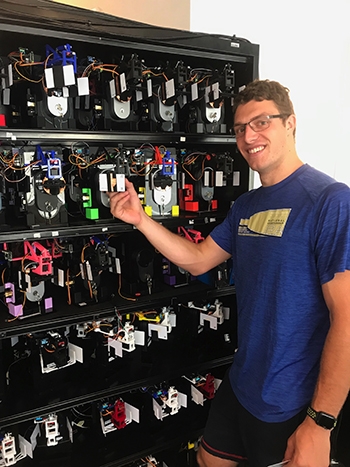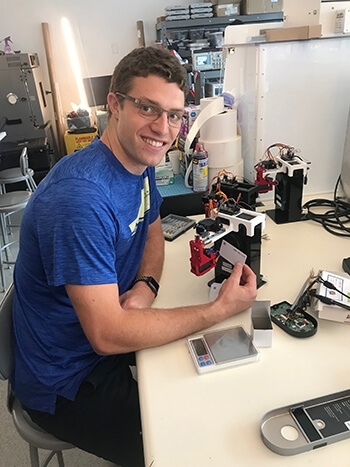Name: Ethan Seder
Concentration: Mechanical engineering
Graduation Year: 2021
Hometown: Berkeley, Calif.
Internship focus: Mechanical engineering
Internship location: New York, N.Y.
Describe your internship.
This summer, reliability robots and I became good friends. As an engineering intern at Latch, I built and assembled reliability robots to conduct closed loop testing on software. Once I finished, the updates were pushed to production as part of Latch’s smart access technology, enabling innovative keyless entry in multifamily buildings. The robots were entirely 3D printed, contained over 30 parts, and were controlled with Arduino powered servos. Due to the high quantity of robots I helped make, I learned a lot about designing durable parts while minimizing 3D printing time.
What is one of the most valuable lessons you learned from this internship, and why?
Design processes for intricate, state-of-the-art technologies are complex and have tons of moving parts. Being a cog in the machinery of a large company helped me to understand how to organize and utilize large numbers of resources. For example, when I needed advice about how best to design a test fixture for holding a printed circuit board, I sought out those that had tackled similar problems, analyzed their suggestions, and determined the optimal solution. I also learned that a team of hard-working individuals can produce much more than that group of individuals working on their own.
What is one of the biggest challenges you faced during this internship, and why? How did you overcome it?
Improving efficiency was my biggest challenge. Our small team assembled over 30 robots. We quickly learned it was inefficient to build complete robots, so we established an assembly-line production scheme. We broke down each assembly function to its simplest level and made one person the “expert” on that sub-assembly. With this adjustment, we increased throughput and were able to make our deadline.
What skills from your courses at SEAS helped you the most during this internship, and why?
The skills that helped me the most during my internship were the intangible skills I learned in SEAS classrooms, including the need to reach out for help when I got stuck and to always break a problem down into smaller parts. The most important tangible skill that came in handy during my internship was the rapid prototyping skills I learned from Computer-Aided Machine Design (ES 51).
Why has this internship been a good experience for you?
In the classroom, it is hard to understand real world applications. Working in the assembly line, I learned how to build 3D parts and put them into robots needed by our customers. It was exciting to learn that the skills I use to solve p-set problems are the same skills needed to succeed in the business world.
How do you think this experience could inform or benefit your future career path?
I knew I loved the academic side of mechanical engineering, but this summer, working with robots and 3D printers and solving real world business problems helped me to realize I also loved the business side of mechanical engineering.
How did you find out about this internship?
I learned about this internship through a friend who worked there.
Press Contact
Adam Zewe | 617-496-5878 | azewe@seas.harvard.edu

